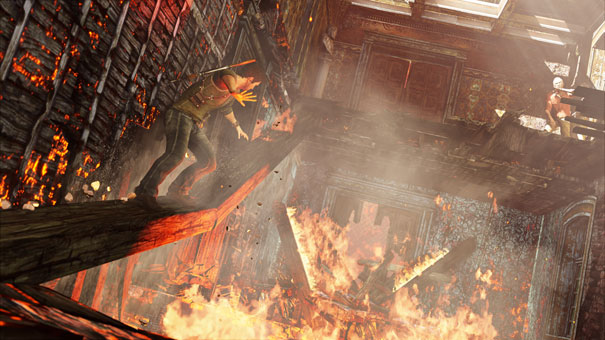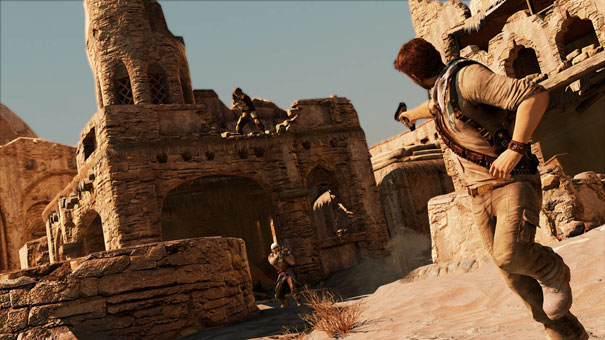Just how good can videogames get? That’s a question Naughty Dog apparently know the answer to, although sometimes you’d wish they just spread the love already and spare us from some of the lesser titles we’ve all made the mistake of buying. But as good as Uncharted 3: Drake’s Deception no doubt is, it’s impossible to discuss it without drawing parallels to the last game in the series. Part deux was, and still remains, not just one of the best games on any console period, but one that managed to set the bar impossibly high for other developers, not least of all for Naughty Dog themselves. But like a band dishing out one multiplatinum (albeit similar-sounding) album after another, they’ve turned out another absolute cracker of a game that’s only tempered by the fact that we’ve all played Uncharted 2 already and there’s no erasing that experience save for a lobotomy. That being said, Uncharted 3 is still an absolute stunner of a game and one that I recommend without reservation (alright, you can skip the rest of this review now), but it isn’t the kind of leap the second game was from the first. Is that really an issue, though? Let’s find out.

We all know the deal by now. The Uncharted series is what an Indiana Jones game could have been had Lucas Arts any brains about them. You hop from one exotic location to another and engage in three specific gameplay types – combat, platforming, and puzzling. All three should be pleasingly familiar to those of you who have played an Uncharted game before, save for a few added kinks in the armour. For those who haven’t (and why haven’t you, exactly?), the shooting and the cover system is immensely tactile and satisfying. There has been some debate with regard to controller stickiness and lag, but it wasn’t something I noticed during my playthrough. In fact, I thought the gun combat was much improved as your enemies now try much harder to flank and flush you out of hiding spots, forcing you to play better. There’s a satisfying recoil to the guns that somehow make them feel more meaty and tangible in Drake’s hands. Friendly AI also does well, taking the fight to the enemy and notching up a decent kill count in the process.
As with the previous games in the series, there are encounters where you’ll find yourself dying more often that you’d like, and feel the odds stacked against you. Persistence pays dividends here, and you’ll find a strategy that works for you soon enough. But boy does the game love boxing you in with a bunch of enemies and watching you sweat! You’ll groan every time you see one of the armoured heavies stomp towards you. There’s a fantastic encounter in a ship graveyard that had the perfect mix of verticality, floating platforms and water, which was as frustrating as it was exhilarating. The hand-to-hand combat has also seen some improvement. Borrowing a page (or three) from Rocksteady Games, you now have a free flowing melee system that lets you fight multiple combatants at once. There’s also a suspiciously familiar counter system that would make a certain Bruce Wayne raise an eyebrow. The random grab events do seem a bit misplaced, however, as they break the flow of combat and force you to button-mash your way out.

There are also huge mini-boss thugs that show up and must be dealt with in the exact same way each time. As fun as the fighting is, I’m sure it wouldn’t have been hard to vary the takedowns a bit. You’ll also find that you’re able to perform context-sensitive actions with items strewn around the environment à la The Bourne Conspiracy. Stealth also enters the mix, but encounters quickly degenerate into firefights after you’ve taken a couple of enemies out. There haven’t been as many changes made to the platforming and puzzling sections, although Naughty Dog have gone and, again, borrowed Dark Void’s excellent vertical cover mechanic. Think shooting people off the ledges above you and you should have a fair idea of how these work. I do wish there were more of the grander platforming sections, though. The camera pulling back while you were shimmying across a wreck in the aforementioned ship graveyard was just spellbinding.
I’ve always liked how Naughty Dog made puzzling such an integral part of their games. Every puzzle is pitched just right in terms of difficulty and the game also procedurally offers clues by way of dialogue the longer you spend on them. Dawdle long enough and you’ll eventually be offered the solution. Drake’s notebook makes a return as well, though you’ll mostly turn to it while trying to puzzle-solve. Perhaps there’s a way to work the notebook into gameplay in the next game; open out the exploring a tad and have Drake look for a specific point on a map, for instance. There are also quiet walking tours around locations where you’re just letting the sights sink in and listening to the most natural back-and-forth banter you’ll hear in a videogame. A handful of on-rails and vehicle segments do show up as well, although one in particular seems like a near identical lift of a similar sequence in Uncharted 2. Also, let’s just say that Read Dead Redemption has spoilt the gaming community as far as horse animations are concerned.
Animation in general is damn near perfect though, and you’ll be hard pressed to think of other changes you’d like to the presentation. Uncharted 3 looks just as good as the second game did, so much so that you’d struggle to find iterative improvements (perhaps the character models and the anti-aliasing are a tad better off?). This isn’t a bad thing, however, as the second game was a master class as far as presentation elements were concerned. The modelling and texture art are nigh on flawless for what the hardware is capable of. Camera work also stands out, especially when pulling out to reveal the enormous scope of your surroundings. Weather, fire, and fluid dynamics also impress, with water in particular being shown off in the game’s Marco Polo moment aboard a pirate ship of all things. Greg Edmondson’s music is as good as ever, infused as it is with eastern instruments in keeping with the game’s environments. The regular voice cast returns as well, and the new members more than match up with quality performances. Cutter in particular is just brilliant, and it’s a shame that he falls by the way side as the story barrels on.
While there are definite similarities between the two titles, I found Uncharted 3 to be ever so slightly tamer in comparison. Without stepping too much into spoiler territory, the game begins with a series of intimate encounters in London and Colombia, and the introduction of a small set of new characters from both Drake’s past and present. They’re all efficient enough to carry the story forward, but you do wish that they got a bit more screen and quality exposition time just so you could delve deeper into their motivations. Now, before I’m told off for looking for too much in a videogame, remember that Drake’s Deception was always pitched as a psychological study of just why Nathan Drake does what he does. In that sense, the game does fall a bit short as, aside from characters questioning Drake’s motivations, we don’t hear enough from the man himself.
I did like that the game doesn’t end with the usual brain-gnawing boss fight; but then you don’t really get much closure either. What saves the story from being a total wash despite all this is the likeability of the characters and the spirit of adventuring that runs through the series itself. You want to forgive them, and the game, for its few faults because the ride is still pitch perfect despite them.
The ten hour-long story mode aside, there is a trio of cooperative modes to sink your teeth into. There’s a campaign-style Adventure mode that offers five alternate missions from the campaigns of both Uncharted 2 and 3, and a horde style Arena mode that has you and your teammates completing objectives while surviving waves of enemies. Both these modes come with their own scoring systems and unlockable perks. There are also competitive modes, including standard and team deathmatch, CTF and an objectives-based mode. In a crowded multiplayer landscape, Uncharted 3 provides enough variety, addictive progression and a buddy system that rewards co-op play to make it a worthy contender.
Conclusion
So does it really matter that Uncharted 3 isn’t as much of a leap from the previous game as some people expected? Not really. Not when it does what it does so well. Naughty Dog has made it clear that they have no intentions of running this series into the ground, so we can be sure that evolution will come. Until then, sit back, lose yourself and enjoy one of the best games to come out this year.